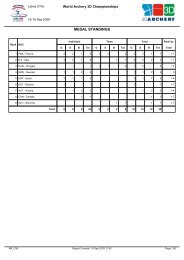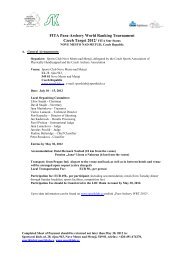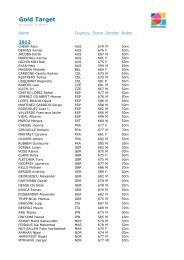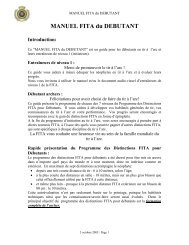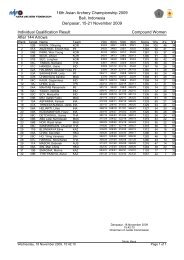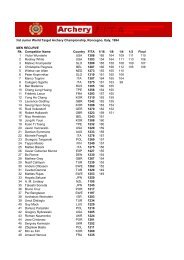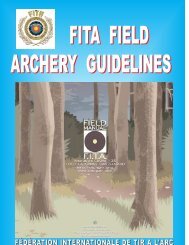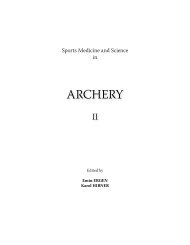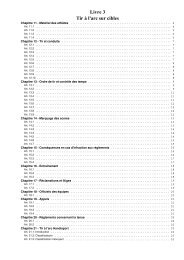Recurve Bow Equipment Tuning - FITA
Recurve Bow Equipment Tuning - FITA
Recurve Bow Equipment Tuning - FITA
Create successful ePaper yourself
Turn your PDF publications into a flip-book with our unique Google optimized e-Paper software.
<strong>FITA</strong><br />
Coach’s<br />
Manual<br />
RECURVE BOW<br />
EQUIPMENT TUNING<br />
Module<br />
Intermediate<br />
Level
<strong>FITA</strong> Coaching Manual<br />
Intermediate Level<br />
Module<br />
RECURVE BOW EQUIPMENT TUNING<br />
Introduction, to tuning competitive recurve bows<br />
There is no doubt that the bow you choose is an important<br />
consideration, but even more important than the<br />
bow are the arrows you choose. In the early days of competitive<br />
archery, it was not uncommon for an archer to<br />
pay a weeks salary for a dozen top quality footed cedar<br />
arrows. Remember, it is not the bow scoring the points in<br />
the target; it is your arrow shafts. Successful bow tuning<br />
and accurate shooting can only be achieved by using arrow<br />
shafts that are properly spined to your bow and ones<br />
that are consistent in their spine, weight and straightness.<br />
Follow the many available spine charts or computer programs<br />
on the market to select the arrow size recommended<br />
for your draw length and bow poundage. Remember to<br />
read all of the information provided on the proper use for<br />
the chart too. The true verification that you have selected<br />
the correct spine will be determined during the tuning<br />
process. Problems caused by improperly spined arrow<br />
shafts will become evident during tuning. Before tuning,<br />
be sure that all arrows are straight, properly fletched, and<br />
have perfectly aligned nocks.<br />
Shooting Technique<br />
Your shooting technique can have a large influence over<br />
the dynamic spine value of your arrow. Two archers<br />
shooting the exact same bow, same poundage and the<br />
same arrow length may not necessarily shoot the same<br />
arrow size. Usually, the archer who has better “line”, (see<br />
shooting form chapter for details on body alignment) will<br />
shoot a lighter (weaker) spined arrow than an archer who<br />
has poor skeletal alignment. This is because the archer<br />
with good alignment creates less side movement of the<br />
string on release resulting in less column loading of the<br />
arrow shaft.<br />
Install All Accessories<br />
Before starting the bow tuning process, be sure to install<br />
every piece of equipment on your bow that you intend<br />
to use during shooting. This includes the correct bowstring<br />
and all attachments to the bow string, bow sight,<br />
stabilizers, arrow rest, cushion plunger, counter weights<br />
etc. Choose all personal items as well, like your tab, chest<br />
protector and any thing else you use when shooting. For<br />
example, simply changing a stabilizer can have an enormous<br />
effect on the tune of your bow. Any adjustments<br />
made to the bow or changes in bow components can and<br />
usually will affect the tune.<br />
Once the equipment is fully assembled, the next phase<br />
in the process of achieving well tuned equipment is good<br />
preliminary setup. If the initial setup is done properly, the<br />
tuning process can be accomplished with little effort. By<br />
following the bow setup guidelines in the initial preparation<br />
of your equipment, you can eliminate most or all of<br />
the possible tuning problems that can make the process<br />
time consuming and unsuccessful.<br />
Adjustments made to the bow, changes in bow components,<br />
or alterations in shooting form can affect the<br />
tune or your equipment. Remember, you and your equipment<br />
share a unique relationship and are totally integrated.<br />
Any change to either will produce varying results.<br />
During the tuning process, it is vitally important that you<br />
change only one variable at a time. Otherwise, it is very<br />
difficult to determine what adjustment caused any grouping<br />
changes. If, after trying all of the tuning adjustments<br />
outlined in this chapter, your arrows still do not fly true, it<br />
may be necessary to change your arrow size to a stiffer or<br />
weaker shaft and retune.<br />
Arrows in flight spin, vibrate and oscillate in the horizontal<br />
plane, and can oscillate in the vertical plane with a<br />
misplaced nocking point. Proper bow-set up and tuning<br />
will help minimize the forces on the arrow and help the<br />
archer to achieve optimum performance. Unfortunately,<br />
there are many theories on arrow flight and vigorous<br />
mathematical treatment of these is a bit hard for most<br />
non-engineers to understand. The bottom line though, is<br />
that all archers can recognize the arrow flight problems<br />
and make appropriate corrections. Figures showing the<br />
rotation of arrows in the horizontal and vertical panes are<br />
shown below.
In this section on recurve bow tuning it will be necessary<br />
to discuss a number of different types of risers since the<br />
available adjustment features differ in each case.<br />
The types of risers are:<br />
• Simple wooden self or take down bows.<br />
• Metal risers with cushion plungers but no weight adjustment<br />
capability.<br />
• Metal risers with cushion plungers & weight adjustment<br />
but no limb pocket adjustment capability.<br />
• Olympic <strong>Recurve</strong> risers (weight adjustable, cushion<br />
plunger and limb alignment capability).<br />
Forces acting on the arrow<br />
For the purpose of simplicity, all discussions from this<br />
point on will be made in reference to a right handed archer<br />
shooting a right handed bow. If the archer is shooting<br />
a left handed bow the same comments apply but in reverse.<br />
As the archer releases the arrow, the string moves horizontally<br />
to the left (facing the target) moving the nock to<br />
the left. As the string starts to move forward moving the<br />
nock end of the arrow, the point end resists this move and<br />
this results in the arrow bending toward the bow. When<br />
the arrow completes this initial bend, the string and nock<br />
move back toward centre and then to the right of centre.<br />
At this moment the front section of the arrow pushes<br />
against the sight window face or a cushion plunger if fitted.<br />
All of this action occurs in a fraction of a second in<br />
the first several inches of forward travel of the arrow. In<br />
the next horizontal bending sequence as the arrow leaves<br />
the bow face and arrow rest the arrow is in a nearly free<br />
Figure 1.<br />
Figure 2.<br />
<strong>Recurve</strong> <strong>Bow</strong> <strong>Equipment</strong> <strong>Tuning</strong> 3<br />
mode, only being held by the bowstring during this second<br />
half cycle. At the end of this complete cycle (bending<br />
in toward then bending away from the bow), the arrow<br />
nock disengages from the bowstring sending the arrow<br />
on its way to the target. These actions of the arrow are<br />
termed “Archer’s Paradox” and are the cause of arrow vibration<br />
and arrow horizontal oscillation.<br />
The drawing shows the position<br />
of the fingers at full draw<br />
and at the time of the release,<br />
the path of the string and the<br />
initial bending of the arrow as<br />
the string propels it<br />
toward the target.<br />
Figure 3.
4<br />
<strong>FITA</strong> Coaching Manual Intermediate Level<br />
Front of Centre Balance (foc)<br />
Arrows fly more accurately and with more stability if they<br />
are front heavy. This is particularly true of shooting in<br />
the wind. The term used to describe the location of the<br />
arrow’s balance point is foc. It is defined as how far the<br />
balance point is forward of the arrow’s mid point and is<br />
expressed as a percentage of total arrow length.<br />
FOC =<br />
L/2− B<br />
×100<br />
L<br />
Where: L is arrow length<br />
B is length from balance point to front of arrow<br />
For outdoor shooting, many archers assemble their arrows<br />
with quite a high Front of Centre balance point,<br />
though this depends on the type of arrows being assembled,<br />
the length of arrow and the poundage/speed of the<br />
bow. Consideration must be given to acquiring a good<br />
sight mark at the longest distance being shot. For indoor<br />
shooting a high Front of Centre balance point may be<br />
used but be aware that going too high may be detrimental<br />
to the performance required.<br />
<strong>Tuning</strong> and <strong>Bow</strong> Set-up<br />
<strong>Tuning</strong> and bow set-up are the processes by which the<br />
archer can adjust the bow and arrow so that the flight<br />
problems caused by the Archer’s Paradox can be minimized<br />
and good arrow grouping can be achieved. The<br />
tuning process is a whole system process wherein the<br />
bow, all of its attachments, the arrow and the archer can<br />
be brought into harmony. Any change, simple as it may<br />
seem, can affect bow tune. Something as simple as a new<br />
set of finger tabs can have a dramatic affect on a finely<br />
tuned bow. The tuning process is a discipline wherein the<br />
shooting characteristics of the arrow are modified to optimize<br />
performance. <strong>Bow</strong> set-up is a series of equipment<br />
based tasks whereas tuning is required to accommodate<br />
the shot variations caused by the archer. Properly made,<br />
matched arrows will group tightly when shot out of a<br />
shooting machine however an archer shooting the same<br />
equipment will experience shot variation.<br />
<strong>Bow</strong> Set-up<br />
Install All Accessories<br />
Before starting the bow tuning process, be sure to install<br />
every piece of equipment on your bow that you intend<br />
to use during shooting. This includes the correct bowstring<br />
and all attachments to the bow string, bow sight,<br />
stabilizers, arrow rest, cushion plunger, counter weights<br />
etc. Choose all personal items as well as, your tab, chest<br />
protector and anything else you use when shooting. For<br />
example, simply changing a stabilizer can have an enormous<br />
effect on the tune of your bow.<br />
Once the equipment is fully assembled, the next phase<br />
in the process of achieving well tuned equipment is a<br />
good preliminary setup. If the initial/preliminary setup is<br />
done properly, the tuning process can be accomplished<br />
with little effort. By following these bow setup guidelines<br />
in the initial preparation of your equipment, you can<br />
eliminate many of the possible tuning problems that can<br />
make the process time consuming and unsuccessful. Adjustments<br />
made to the bow, changes in bow components,<br />
or alterations in shooting form can affect the tune of your<br />
equipment. Remember, you and your equipment share a<br />
unique relationship and are totally integrated. Any change<br />
to either will produce varying results. During the tuning<br />
process, it is vitally important that you change only one<br />
variable at a time. Otherwise, it is very difficult to determine<br />
what adjustment caused any grouping change.<br />
Nock-to-<strong>Bow</strong>string Fit<br />
The force necessary to separate the nock from the bowstring<br />
serving is very critical, especially on light drawweight<br />
bows (35 lbs. and under). Nock tension should<br />
be tight enough so the arrow can easily support its own<br />
weight when the arrow is hung from the bowstring in a<br />
horizontal position but weak enough so that the arrow<br />
will fall if the string is tapped sharply with your finger (see<br />
figure 4 below). In order to get the proper nock fit you<br />
can use either a large or small groove nock or adjust the<br />
serving diameter by choosing different serving thread diameters.<br />
If the string tension is too loose, there is a danger<br />
of the nock slipping off the string at full draw causing a<br />
dry fire. This could not only damage the bow, but can also<br />
cause a serious bruise to the archers bow arm.<br />
Figure 4.
Install the Arrow Rest<br />
A wide variety of arrow rests is available to the archer.<br />
They all have one thing in common – they must be fitted<br />
so that the angle of the arm assists the arrow to stay on<br />
the rest and does not allow the arrow to slide off the rest<br />
before the shot is made (figure 5). Rests range from the<br />
simple stick on plastic variety to adjustable metal arms<br />
which move away from the arrow as it is shot. The high<br />
speed films described earlier show that the main function<br />
of the rest is to support the arrow during draw and during<br />
the initial movement of the arrow forward. As archer’s<br />
paradox takes place the arrow lifts off the rest. The rest<br />
needs to be adjusted so that the centre of the arrow is contacting<br />
the centre of the cushion plunger (Figure 5), and<br />
the support arm must be adjusted so that it is not visible<br />
past the outside of the arrow shaft when observed from<br />
an overhead view (figure 6).<br />
Incorrect Incorrect Correct<br />
Figure 5<br />
Angle of arrow rest arm &<br />
Plunger alignment with the arrow.<br />
Incorrect Correct<br />
Figure 6<br />
Arrow Rest Arm.<br />
Install the Nocking Point<br />
This is a common step with all recurve bows. Install a<br />
moveable nocking point on the bowstring. Clamp-on<br />
types are satisfactory and easy to install but affect arrow<br />
flight. We suggest that you use a tie on nocking point.<br />
<strong>Recurve</strong> <strong>Bow</strong> <strong>Equipment</strong> <strong>Tuning</strong> 5<br />
Initial Nocking Point Position.<br />
90°<br />
Have the top of the<br />
boom nocking point<br />
approximately 5<br />
millimetres above<br />
square.<br />
Figure 7.<br />
Initially, position the nocking point on the bowstring<br />
about 5mm (1/4 inch) above square (Figure 7).<br />
The nock of the arrow will be placed above this nocking<br />
point. After this nocking point is in place tie a 2nd<br />
nocking above the first one with sufficient room between<br />
the two points so that a nock will easily fit between. This<br />
will prevent an arrow from sliding down the string during<br />
shooting.<br />
Tying on a Nocking Point<br />
The tied on nocking point is made with a short piece, 30-<br />
50cm (12-20˝) of the same serving material used to serve<br />
the string. Begin by tying an overhand knot around the<br />
bowstring serving. Next take the free ends, turn them under<br />
the bowstring and tighten the knot. Alternate knots<br />
above and below the string until you have tied 8-10 knots.<br />
End the nocking point by tying the final knot in a square<br />
knot. Cut off the loose ends to about 5mm (1/4˝) length<br />
and heat them with a match or lighter. They will burn back<br />
to the main knot and fuse the fibres of the string you used<br />
for the nocking point. This nocking point can be moved<br />
up or down the serving by twisting it since it acts like a<br />
nut and the served string as the screw. This is the reason<br />
you should use the same material as you used for the serving<br />
since you get a perfect thread match.
6<br />
<strong>FITA</strong> Coaching Manual Intermediate Level<br />
Figure 8.<br />
Tying on a simple Nocking Point<br />
Or you can tie a temporary and more simple one, as<br />
shown in Figure 9 below.<br />
Serving material or dental oss can be<br />
used for making a nocking point.<br />
e drawing below shows a way to<br />
eliminate knots or loose ends<br />
When the nock is completed cut<br />
the ends off and add a little glue<br />
Figure 9.<br />
Finding the Limb Centres<br />
In order to have a reference point from which to adjust<br />
the arrow’s left/right position on the bow, it is necessary<br />
to find and mark the exact centre of the limbs on your<br />
recurve bow. During the whole set-up process the bow<br />
should be mounted on a bow vice so that the limbs do not<br />
touch anything since this could distort the fragile limbs.<br />
An elaborate vice is commercially available but a simple<br />
tool can be made of wood to accomplish this (see Figure<br />
10).<br />
Figure 10<br />
Hardwood <strong>Bow</strong> Vice<br />
25mm 100mm × 300mm<br />
25mm × 25mm × 200mm<br />
8mm Hole<br />
The wooden vice can be set to hold the bow either vertically<br />
for limb/arrow alignment or horizontally for serving<br />
the string (see Figure 11).<br />
Figure 11.<br />
<strong>Bow</strong> Orientation in Vice
To find the limb centre for a recurve bows, place a piece<br />
of masking tape across the inside of each limb near the<br />
limb pockets). Measure the width of each limb and make<br />
a small vertical mark on the tape in the exact centre of<br />
each limb about 15cm (6 in.) from the limb pockets of the<br />
riser. Be very accurate when doing this and measure several<br />
times to know you have located the exact centre of<br />
each limb. This mark will be used for arrow centering. It<br />
may be easier to see if the string is centralised if two lines<br />
are marked on the limb, instead of one, which are 3 millimetres<br />
apart. With one line this line would be hidden<br />
behind the string when alignment is being checked. More<br />
conveniently use commercially available “Limb Line<br />
Gauges” available from most good archery shops.<br />
After you mark the limb centres on the tape or install<br />
the Limb Line Gauges, stand back and attempt to sight<br />
align the string with the 2 marks. If you cannot do this<br />
you will need to either average the alignment or if your<br />
bow has the capability of adjusting limb alignment, do so.<br />
This is most easily accomplished by placing one marked<br />
tape where the limb comes out of the riser and one tape<br />
at 15cm (6in.) from the bow tip on both limbs (or use specific<br />
gauges). You can then check the alignment of the 4<br />
marks to assess if the limbs are properly aligned (Figure<br />
12). Stand back and sight through the string to see if it<br />
covers all 4 marks. If not, make limb alignment adjustments<br />
as required.<br />
Some bows may have a slightly bent riser or crooked<br />
limbs. In this case, since the string will not perfectly bisect<br />
the centre of both limbs at the same time, you will need<br />
to compensate or average the string position for the slight<br />
imbalance. This does not mean the bow will not shoot accurately,<br />
it simply means you need to compensate for this<br />
situation.<br />
<strong>Recurve</strong> <strong>Bow</strong> <strong>Equipment</strong> <strong>Tuning</strong> 7<br />
Figure 12.<br />
“Centering” the Arrow: Adjusting the Arrow’s Left/<br />
Right Position<br />
The objective of arrow centering is to have the arrow leave<br />
the bow in the same vertical plane as the average string<br />
force moves. To accomplish this, the archer should stand<br />
behind the bow which is held in a vertical position and<br />
sight forward through the string which is aligned with<br />
the bow centreline. See Figure 13 for proper arrow centering.<br />
The arrow should be moved in or out from the bow<br />
so that the point appears just to the left of the string. For<br />
bows equipped with a cushion plunger this can be accomplished<br />
by turning it in or out. <strong>Bow</strong>s without a cushion<br />
plunger can be built out from the bow face if the arrow<br />
must be moved left however if the point is already outside<br />
of the string it is impossible to move the point further<br />
right because of the riser.<br />
Figure 13. Figure 14.
8<br />
<strong>FITA</strong> Coaching Manual Intermediate Level<br />
Align the <strong>Bow</strong> Sight Pin or Aperture:<br />
Set the sight pin or aperture on your bow sight directly<br />
over the string when it is aligned down the centre of the<br />
bow, see figure 14. The one object of the tuning process<br />
which follows is to select the correct arrow and bow adjustment<br />
so that the arrow is aimed and moves forward<br />
in the force plane of the moving bowstring as the arrow<br />
is shot. You will notice a number of archers whose sight<br />
is either outside or inside the string. This is because they<br />
have tuned their bows to an improper initial arrow alignment<br />
or are using arrows either too stiff or too weak for<br />
their set-up.<br />
Notes on Clickers<br />
There are several things to be aware of when using<br />
a clicker. Be sure that the arrow is well supported<br />
on the rest and not held in place only by the tension<br />
of the clicker. Draw the bow a few times without the<br />
clicker to make sure the arrow can be drawn and let<br />
down without the arrow falling off the arrow rest. The<br />
clicker tension and angle are important too. The clicker<br />
should not be so stiff that it actually moves the cushion<br />
plunger in or places a downward pressure on the<br />
arrow. To test this, stand in front of a target (just in case<br />
you have an unexpected loose of the string) and draw<br />
the arrow through the clicker as if you were going to<br />
shoot, but do not shoot the arrow. Rather, watch only<br />
the arrow on the rest to detect any movement of the<br />
arrow at the moment the arrow is pulled through the<br />
clicker and the clicker makes contact with the riser. If<br />
there is any movement of the arrow, either a bounce on<br />
the arrow rest or the arrow moves out due to cushion<br />
plunger activation, you need to correct this. There must<br />
not be any observable movement of the arrow when the<br />
clicker is activated.<br />
Set the Cushion Plunger Pressure<br />
If the bow is equipped with a cushion plunger, set the<br />
plunger tension to 40% of the tension of the lightest<br />
spring. The setting will change later on in the tuning<br />
process. If you don’t use a cushion plunger, your tuning<br />
adjustments are going to be far more limited in the tuning<br />
process.<br />
Setting Initial Brace Height<br />
Start with the brace height at the lower end of the manufacturer’s<br />
recommendation range or use the following<br />
chart.<br />
64˝ 8 1/8˝–8 3/8˝ (21.0 cm–21.6 cm)<br />
66˝ 8 1/4˝–8 1/2˝ (21.3 cm–21.9 cm)<br />
68˝ 8 3/8˝–8 5/8˝ (21.6 cm–22.2 cm)<br />
70˝ 8 1/2˝–8 3/4˝ (21.7 cm–22.5 cm)<br />
The manufacturer recommended brace height setting is<br />
only a guideline. Changing the brace height to a slightly<br />
higher or lower position can affect arrow flight and grouping.<br />
The proper setting for best arrow grouping performance<br />
will be determined later in the tuning section.<br />
Tiller<br />
Tiller is the term used to describe the relative bending<br />
of both bow limbs. It is assessed by measuring the perpendicular<br />
distance between the bow string and limb at<br />
the end of the limb pockets. By convention, the readings<br />
are made in reference to the upper limb reading. Hence, a<br />
positive tiller is one where the distance from the string to<br />
the upper limb at the limb pocket (a) is greater than the<br />
distance for the lower limb (b), see figure 15.<br />
Figure 15.<br />
A negative tiller is where the lower reading is greater. For<br />
many years it was accepted that a positive tiller was required<br />
since the archer was grasping the string above the<br />
bow centre and held the string with one finger above and<br />
two below the arrow nock and was a result of the pressure<br />
point of the hand on the riser. Recently most archers<br />
adjust the tiller to zero or leave it where the manufacturer<br />
(a)<br />
(b)
made the limbs. The latter is probably a bad idea since<br />
some limb pairs as purchased can have an initial tiller as<br />
high as 20mm (3/4 inch).<br />
Some archers and coaches feel that it is necessary to<br />
adjust the tiller to keep the sight steady on the target. To<br />
do this, make very small adjustments to tiller (less than<br />
2mm at a time) and see how your sight pattern is affected.<br />
Another indication that the tiller is correct is the bow<br />
hand will feel like one concentrated point rather than<br />
a slight rocking feeling in the hand. On the other hand,<br />
many archers and coaches set the tiller at zero and leave<br />
it there.<br />
One note of caution. Changing tiller moves the location<br />
of the nocking point and its position must be readjusted<br />
after each change in tiller. Increasing tiller moves<br />
the nocking point down and reducing tiller moves the<br />
nocking point up in relation to the arrow rest. The nocking<br />
point must be relocated after each tiller change. Do<br />
not use tiller adjustments as a means of moving the nocking<br />
point since changes in tiller affect how the bow performs.<br />
Setting the Final Brace Height<br />
All bows are different, even bows of the same make and<br />
model can have small variations in limb length. Therefore,<br />
it is important to locate a brace height that fits your<br />
particular bow and shooting style. Shoot a few arrows at<br />
the suggested beginning brace height, then unstring the<br />
bow, add 3-4 twists to the bowstring and shoot again.<br />
Continue this process until the bow feels smoothest and<br />
quietest when shooting.<br />
If the bowstring is too short to allow a brace height<br />
at the lower setting, use a slightly longer string. If the<br />
string is too long to allow a higher brace height (and<br />
starts to knot-up from too many twists), try a slightly<br />
shorter bowstring. There are many custom bowstring<br />
makers who produce strings to your exact specifications<br />
including length, type of material, number of strands in<br />
the string and type and colour of serving. If there are<br />
a lot of twists in the string, it will take fewer twists to<br />
increase brace height than if there are few twists in the<br />
string. Also, it is not recommended to have too many<br />
twists in the string or it will act more like a spring than<br />
a string. But, there should be enough twists to make it<br />
look like a nice round cable.<br />
<strong>Recurve</strong> <strong>Bow</strong> <strong>Equipment</strong> <strong>Tuning</strong> 9<br />
<strong>Tuning</strong><br />
General<br />
After the bow is set-up as outlined above, the archer may<br />
begin the tuning process.<br />
As described earlier, the finger release causes the arrow<br />
to vibrate and to oscillate in the horizontal plane. Arrow<br />
flight appears to follow a snake like movement pattern.<br />
These movements of the arrow are caused by archer’s<br />
paradox where the string moves around the fingers on release.<br />
The goal of tuning is to select and adjust an arrow’s<br />
flight characteristics to minimize these effects and to get<br />
the arrow to leave the bow with zero deg. angular rotation.<br />
It will still be vibrating but these vibrations are dampened<br />
out in the first 20-25m of flight by drag forces on the arrow<br />
shaft. <strong>Tuning</strong> will also minimize the archer’s shooting<br />
form variability and help him get smaller groups.<br />
Your shooting technique can have a large influence<br />
over the dynamic properties of your arrow. Two archers<br />
shooting the exact same bow, same poundage and the<br />
same arrow length may not necessarily require the same<br />
arrow size. Usually, the archer who has better “line”, (see<br />
shooting form chapter for details on body alignment)<br />
will shoot a lighter (weaker) spined arrow than an archer<br />
who has poor skeletal alignment. This is because the<br />
archer with good alignment creates less side movement<br />
of the string on release resulting in less initial bending of<br />
the arrow shaft.<br />
As will be shown shortly, there are a number of interacting<br />
tuning variables which can be employed to best<br />
tune your system. There is not one unique set-up of these<br />
variables to achieve the desired minimum group size you<br />
are seeking. In fact, it is normal to be able to achieve a<br />
good bow tune with more than one stiffness grade of arrow.<br />
With this in mind, many people prefer to tune their<br />
bow with a stiffer arrow because it is believed to be more<br />
forgiving. Forgiving in this sense is that the arrow will<br />
readily accommodate variations in the archers shooting<br />
technique.<br />
<strong>Tuning</strong> is best carried out as a statistical process. Each<br />
arrow should be numbered to see if there is any flight<br />
bias, good or bad, associated with that arrow. The archer<br />
should shoot more than the minimum of shots to characterize<br />
their arrow flight. For example, if the method calls<br />
for shooting 1 or 3 arrows from a given distance it is suggested<br />
that the archer shoots at least 6 shots. The archer<br />
can then eliminate or discount any obvious poor shots<br />
from consideration.
10<br />
<strong>FITA</strong> Coaching Manual Intermediate Level<br />
<strong>Tuning</strong> Methods<br />
There are a number of tuning methods used today but<br />
most are either lengthy or inaccurate. Many depend on<br />
the use of bare shafts as a primary reference for fletched<br />
arrow flight. Bare shafts do not have good flight characteristics<br />
unless the bow is fairly well tuned. Some of the<br />
tuning methods used and comments on them are:<br />
Paper <strong>Tuning</strong>: Primarily a compound bow with release<br />
aid tuning method. Because of archer’s paradox and the<br />
resultant arrow flight this method has little validity for<br />
people using their fingers to release the arrow.<br />
Walk Back <strong>Tuning</strong>: Involves shooting arrows at distances<br />
of 20-40 metres without moving the sight and aiming<br />
at the same point and then analyzing the hit pattern. This<br />
method is not sufficiently sensitive in tuning carbon/aluminium<br />
shafts but is said to work satisfactorily with aluminium<br />
arrows.<br />
Short Distance <strong>Tuning</strong>: This method involves shooting<br />
fletched arrows at a vertical and a horizontal line. It is<br />
used mainly to verify nocking point and cushion plunger<br />
in/out setting.<br />
Bare Shaft Planing Test: This method compares the<br />
grouping pattern of bare and fletched shafts. It produces<br />
good results but shooting bare shafts before a good tune<br />
is achieved may be frustrating for the archer.<br />
Fletched Arrow Group <strong>Tuning</strong>: This method has been<br />
used for many years and does not have a name. It is probably<br />
the simplest method that yields the best results of<br />
other tuning methods and is highly recommended. It can<br />
also involve shooting bare shafts but not before a basic<br />
tune is established.<br />
<strong>Tuning</strong> Tools<br />
In all of the tuning methods a number of variables can<br />
be used to adjust the shooting characteristics of an arrow.<br />
All of the following deal with the arrow’s dynamic spine<br />
which is the amount of initial bend the arrow undergoes<br />
as the string is released. It is how weak or stiff the arrow is<br />
as it is shot. Most frequently this characteristic is referred<br />
to as the arrow’s spine. Unfortunately, arrow manufacturers<br />
also use the same term, spine, to describe the stiffness<br />
of their shafts. These two “spines” are really “static<br />
spine” or the stiffness of the arrow at rest as measured by<br />
a spine or deflection tester and “dynamic spine” which is<br />
the bending characteristics of an arrow as it is shot from<br />
the bow.<br />
Factors Affecting Dynamic Spine<br />
Dynamic spine is affected by a number of factors, most of<br />
which can be adjusted to improve arrow flight.<br />
Adjustments to increase dynamic spine, “making the arrow<br />
shoot stiffer<br />
• decrease point weight<br />
• add weight to the nock end of the arrow<br />
• shorten the shaft<br />
• decrease bow weight<br />
• decrease brace height. Be careful here as this gives a<br />
longer power stroke thus makes the arrow seem weaker.<br />
• increase string weight<br />
• change arrows to a stiffer shaft size, i.e., lower static<br />
spine value.<br />
Adjustments to decrease dynamic spine, “making the arrow<br />
shoot weaker or bend more”<br />
• increase point weight<br />
• lengthen the shaft<br />
• increase bow weight<br />
• increase brace height be careful here as this gives a<br />
shorter power stroke thus makes the arrow seem stiffer.<br />
• decrease string weight<br />
• change arrows to a weaker shaft size, i.e., increase static<br />
spine value.<br />
There are some limitations in applying these changes. The<br />
point weights are determined by what the archer can purchase.<br />
If the archer is using aluminium arrows he can add<br />
lead to the inside of the point to increase its weight. It is<br />
obvious that you can cut off some of the arrows shaft to<br />
shorten it but you can’t lengthen the shaft without purchasing<br />
new shafts. If you increase bow weight you may<br />
get to the point the bow is too heavy for you to control.<br />
<strong>Bow</strong>string<br />
Serving weight (centre serving) can affect dynamic spine.<br />
For example, monofilament centre serving will cause the<br />
arrow to react stiffer than lighter weight nylon centre<br />
serving. Simply changing from a metal nocking point to<br />
a “tie-on” nocking point can have a noticeable affect on
arrow spine due to the weight difference between the two<br />
styles of nocking points.<br />
Objective of <strong>Bow</strong> <strong>Tuning</strong><br />
The goal of tuning your bow is to set it up so that you<br />
can get the smallest group possible within your shooting<br />
ability.<br />
Many people look for the best arrow flight or being<br />
able to shoot bare shafts into the fletched shaft group.<br />
There are many incidences where elite archers get excellent<br />
groups without perfect arrow flight. It is also normal<br />
for the bare shafts to hit just outside the fletched shaft<br />
group. Since bare shafts are lighter than fletched shafts<br />
and have a no rear weight (the fletchings), depending on<br />
the distance being shot, it might be expected that the unfletched<br />
shafts would hit higher and to the left (right hand<br />
archer) of the fletched shafts.<br />
Starting the <strong>Tuning</strong> Process<br />
Follow the many available manufacturers’ spine charts to<br />
select the arrow size recommended for your draw length<br />
and bow poundage to use as a starting point in developing<br />
the proper arrows for you. Read all of the information<br />
provided on the proper use of the chart. Many people<br />
have found that the arrow sizes recommended by the<br />
manufacturer is at least one stiffness grade too stiff so it<br />
may be wise to try the arrows or pick one grade less stiff<br />
shaft as a starting point.<br />
Verification that you have selected the correct spine<br />
will be determined during the tuning process. Problems<br />
caused by improperly spined arrow shafts will become<br />
evident during this process. Before tuning, be sure that all<br />
arrows are straight, properly fletched, and have perfectly<br />
aligned nocks. Now that you have completed the preliminary<br />
adjustments and properly set up your bow, you are<br />
ready to start the tuning process.<br />
Establishing a Basic Tune<br />
It is suggested that you begin with the Bare Shaft test.<br />
Shoot bare shafts at a target at 5m. In this way you will<br />
see how the shaft leaves the bow and you can adjust your<br />
nocking point and cushion plunger as needed. Adjust the<br />
nocking point as shown in Figure 16.<br />
<strong>Recurve</strong> <strong>Bow</strong> <strong>Equipment</strong> <strong>Tuning</strong> 11<br />
Arrow shafts are without fletchings.<br />
The nocking point is too high.<br />
Figure 16.<br />
Arrow shafts are without fletchings.<br />
The nocking point is too low.<br />
Figure 17.<br />
Fishtailing: (caused buy mismatched arrow<br />
spine).<br />
If the arrow leaves the bow with the nock end leaning to<br />
one side or the other, fishtailing occurs. The nock end of<br />
the arrow will appear to move from side to side as the arrow<br />
follows its flight path. See Figure 18.<br />
Figure 18.<br />
Using the Bare Shaft Planing Test to correct fishtailing,<br />
continue to shoot three fletched shafts and two or three<br />
identically aimed unfletched shafts. Again, make sure the<br />
bare shafts will hit the target before moving back further<br />
than 20 yards. If the unfletched shafts impact left of the<br />
fletched shafts, the arrow is too stiff (for a right-handed<br />
archer, opposite (weak) for a left hand archer). If the bare<br />
shafts impact more than 2˝ to 3˝ inches (5 to 8 cm) at 20<br />
yards, this will mean that the bare shafts will be well away<br />
from the fletched shafts at a longer distance like 30 meters<br />
and may not even hit the target. In this case, is not<br />
likely that any decrease the spring tension on the cushion<br />
plunger will be much help. It is better to use a more effective<br />
gross adjustment, or a combination of adjustments<br />
before working with the cushion plunger (making sure<br />
that the cushion plunger is still set at a medium spring ten-
12<br />
<strong>FITA</strong> Coaching Manual Intermediate Level<br />
sion). If your bow weight is adjustable, increase the bow<br />
weight by approximately 1 pound. An adjustment more<br />
than one pound is not recommended unless the archer is<br />
in very good physical condition and even then an archer<br />
should never increase more than 2 pounds at a time as it<br />
could have detrimental affects on shooting technique and<br />
possibly induce an injury. Other gross adjustments that<br />
will improve the spine compatibility of an arrow that is<br />
too stiff are an increase in arrow point weight and a reduction<br />
in the number of strands in the string (reducing the<br />
physical weight of the bowstring). In the same relation,<br />
a decrease in the weight of the centre serving material or<br />
a decrease in the length of the centre serving will have a<br />
similar effect as well as a reduction in the weight of the<br />
nocking point (example: changing from a metal nocking<br />
point to a tie-on type).<br />
If the unfletched shafts impact right of the identically<br />
aimed fletched shafts (weak), (for a right-handed archer,<br />
opposite (stiff ) for a left hand archer), decrease bow<br />
weight slightly (if your bow weight is adjustable) and or<br />
decrease arrow point weight. Here, the bow weight would<br />
be your best adjustment to move the bare shafts into or<br />
near the same group as the fletched shafts. Going down<br />
in bow weight is not a problem other than losing a little<br />
arrow speed. Your equipment is basically tuned when<br />
the bare shafts and fletched shafts impact at the same or<br />
very near the same location. Once you have completed<br />
the Fine <strong>Tuning</strong> process do not be surprised if the bare<br />
shaft impact changes. It is common on a well-tuned bow<br />
to have the bare shafts impact a different location than<br />
the fletched shafts. Usually, a good tune will have the bare<br />
shafts impacting close to the fletched shafts in the horizontal<br />
plane, but if the nocking point height is not correct<br />
the bare shaft impact position may be slightly higher or<br />
lower than the fletched shafts impact position.<br />
Cushion Plunger Setting<br />
When correcting fishtailing using the Bare Shaft Planing<br />
Test, use the cushion plunger for fine adjustments only and<br />
not for large horizontal adjustments. It is important to first<br />
have good spine compatibility for the bow before using the<br />
cushion plunger to correct gross errors in spine. In the fine<br />
tuning process, the cushion plunger’s ability for improving<br />
grouping will become evident. Also, it is important to note<br />
that when adjusting the cushion plunger tension, it will almost<br />
always affect nocking point height as well as dynamic<br />
spine. Don’t be surprised if the bare shaft impacts change in<br />
height as well as horizontal impact.<br />
If during the tuning process you are unable to get the<br />
unfletched shafts to impact near the fletched shafts in<br />
the horizontal plane, it will most likely be necessary to<br />
change arrow sizes. Your arrows might be too weak (the<br />
unfletched shaft impacts to the right of the fletched shaft<br />
for right-handed archers) or too stiff (the unfletched<br />
shaft impacts to the left of the fletched shaft for righthanded<br />
archers). If, after completing this test, the bare<br />
shaft impact is more than 3 inches (8 cm) to the right<br />
(weak) or left (stiff ) of the fletched shafts at 20 yards<br />
(18 m), you will most likely need to change shaft size.<br />
However, before going to this more costly investment,<br />
make sure you are not having a false tuning indicator<br />
caused by a clearance problem. Usually, incompatible<br />
arrow spine is the biggest cause of a clearance problem,<br />
but not always.<br />
Clearance<br />
To check for clearance, use dry powder foot spray, dry<br />
deodorant spray or similar product applied to the last<br />
quarter of the arrow shaft, fletching, arrow rest assembly<br />
and sight window near the arrow rest. Do not disturb the<br />
powder sprayed on the arrow and bow while preparing to<br />
shoot. The arrow should be shot into a firm target so that<br />
it will not penetrate to the powder area. Then check the<br />
powder on the arrow to see if there are any marks indicating<br />
an impact between the arrow and bow.<br />
Correcting Clearance Problems<br />
If you are not achieving good arrow clearance, and the arrow<br />
fletching and bow make contact, optimum grouping<br />
cannot be achieved. By examining the areas where the dry<br />
powder spray is scraped off, the nature of any interference<br />
can be determined, and the position of the fletching as the<br />
arrow leaves the bow can be identified. If there is a clearance<br />
problem, this can usually be seen in the arrows flight<br />
to the target. A term used to explain the visual flight disturbance<br />
is called Minnowing. Like fishtailing or Porpoising,<br />
Minnowing describes a specific arrow flight disturbance.<br />
Minnowing will appear to look much like fishtailing except<br />
that the tail of the arrow appears to move from side to<br />
side more quickly, and the amount of side swing is usually<br />
much less than in fishtailing. See Figure 19.<br />
Figure 19.
Minnowing indicates inadequate clearance and is caused<br />
by the rear portion of the arrow (usually fletching) contacting<br />
the arrow rest or cushion plunger. The following<br />
procedures can help you correct clearance problems that<br />
cause minnowing:<br />
• If the arrow fletching is hitting the arrow rest, try rotating<br />
your arrow nock 1/32 of a turn. Continue rotating<br />
the nock in 1/32-turn increments until clearance is<br />
achieved.<br />
• Make sure your arrow rest support arm does not protrude<br />
past the outside of the arrow shaft when the arrow<br />
is resting on the support arm and is lying against<br />
the cushion plunger or side loading device. See Figures<br />
5 & 6.<br />
• Choose a lower profile fletching.<br />
• Follow the procedures for <strong>Tuning</strong> Adjustments for<br />
nock indexing and arrow rest set up.<br />
• Make sure the bow hand is well relaxed to eliminate<br />
bow hand torque.<br />
• Move the cushion plunger slightly out from the bow<br />
to help increase clearance if the other tuning modifications<br />
have no effect.<br />
Trouble-Shooting Arrow Groups<br />
You may have heard someone say, “If your arrows group<br />
well at 20 yards, they will group at any distance,” or, “If<br />
your arrows group at long distances, they will group at<br />
short distances.” In some cases, neither statement is true.<br />
There may be a minute disturbance in the equipment that<br />
affects the equipment’s potential for superior accuracy<br />
causing poor arrow grouping. What follows here is information<br />
that will help you perform the fine tuning adjustments<br />
necessary to eliminate most or all of the minute<br />
tuning problems.<br />
Many archers have experienced one or all of the following<br />
arrow grouping/arrow flight combinations: poor<br />
arrow flight and good grouping. This is commonly the<br />
result of a stiff arrow. The arrow yaws slightly as it leaves<br />
the bow, but usually recovers quickly and often produces<br />
very acceptable grouping.<br />
Good arrow flight and poor grouping. Although this<br />
seems contradictory, the phenomenon is somewhat common<br />
and relates to the tuning method used, or a lack of<br />
fine tuning. Having perfect arrow flight, or having the<br />
bare shafts impact exactly with the fletched shafts using<br />
the Bare Shaft Planing Test, does not always mean your<br />
arrows will group well; it only means the arrows fly well.<br />
<strong>Recurve</strong> <strong>Bow</strong> <strong>Equipment</strong> <strong>Tuning</strong> 13<br />
The section on Fine <strong>Tuning</strong> will assist you in obtaining<br />
optimal grouping from your equipment as well as good<br />
arrow flight. It is best to work toward good arrow flight<br />
and good grouping as this will produce the most consistent<br />
results in any weather and especially windy conditions.<br />
Arrow grouping patterns often reveal probable arrow<br />
flight problems. Two of the most common grouping indicators<br />
for determining arrow flight problems are described<br />
below.<br />
Excessive Drag<br />
If the arrow has too much drag, that is the fletchings are<br />
too large or the fletch are off-set too much, it can cause<br />
excessive drag and grouping will often suffer at long distance.<br />
For example, if shooting <strong>FITA</strong> distances of 90, 70,<br />
50 and 30 meters for men and 70, 60, 50 and 30 meters<br />
for women, you may experience good grouping on all<br />
distances except for the longest distance. If this is the<br />
case, the arrow most likely has too much drag. Excessive<br />
drag will cause the arrow to become unstable due<br />
to the rapid decay of its forward velocity. When forward<br />
velocity drops too quickly, instability occurs. This unstable<br />
flight causes poor grouping at long distances and<br />
extreme vulnerability to wind drift. On lightweight arrows,<br />
it is very important to reduce drag to a minimum<br />
to maintain maximum downrange velocity. This can be<br />
done by reducing the size (height and/or length) of the<br />
fletching or by reducing the angle of the fletching, or<br />
both.<br />
Insufficient Clearance<br />
A clearance problem will usually have the opposite effect<br />
of excessive drag. Most often arrow grouping is acceptable<br />
at longer distances, however, the shorter distance<br />
groups are not reduced in size proportionately to those<br />
at the longer distances. This situation commonly results<br />
in short distance scores that are significantly less than<br />
what the longer distance scores would indicate. If this is<br />
a familiar scenario, look for a clearance problem or micro<br />
disturbance within the bow and arrow system. To correct,<br />
see the section on Clearance.<br />
Adjusting the <strong>Bow</strong> and Arrow System<br />
If you are having problems tuning your bow, you will<br />
need to make some modifications to your equipment to<br />
achieve a better tune. Here are some suggestions:
14<br />
<strong>FITA</strong> Coaching Manual Intermediate Level<br />
<strong>Bow</strong> Weight Adjustment<br />
Virtually all target quality recurve bows have an adjustable<br />
draw weight system. <strong>Bow</strong> weight adjustment should<br />
be the first tuning consideration if your arrow reaction is<br />
significantly stiff or weak. It is important not to increase<br />
bow weight more than one to two pounds as it could have<br />
detrimental effect on shooting technique. Here is a good<br />
guideline to follow to know if you can physically handle<br />
any increase in bow weight. Simply draw and hold your<br />
bow at full draw for 60 seconds. If it you can hold the<br />
weight for an entire minute, you can handle the one to<br />
two pound increase. If the arrow reaction is too stiff when<br />
applying the bare shaft tuning test, increase the draw<br />
weight. If your arrow reaction is too weak, decrease the<br />
draw weight.<br />
<strong>Bow</strong>string<br />
<strong>Bow</strong>string “weight” can have a significant effect on arrow<br />
spine. Increasing or decreasing the number of strands in<br />
the bowstring can influence the arrow’s dynamic spine<br />
enough to require a shaft size change of up to one full size<br />
weaker or stiffer. If your arrow reaction is too stiff, decrease<br />
the number of strands in your bowstring. If your arrow reaction<br />
is too weak, increase the number of strands. Serving<br />
weight (centre serving) can also produce the same effect.<br />
For example, monofilament centre serving will cause<br />
the arrow to react stiffer than lighter weight nylon centre<br />
serving. Simply changing from a metal nocking point to<br />
a “tie-on” nocking point can have a noticeable effect on<br />
arrow spine as well due to the weight difference between<br />
the two styles of nocking points.<br />
Point and Insert Weight<br />
The arrows dynamic spine can be tuned by using various<br />
point and/or insert/outsert weight combinations. If your<br />
arrow is too weak, go to a lighter insert or point. If your<br />
arrow is too stiff, try a heavier insert or point. Continue to<br />
change insert and/or point weights within an acceptable<br />
balance point range (10–18% F.O.C.).<br />
Documenting <strong>Equipment</strong><br />
Once you have completed the Bare shaft Planing Test and<br />
before starting the fine tuning process, it is important to<br />
write down the exact measurements of your bow. Having<br />
all of the equipment information documented will allow<br />
you to return to the initial settings if something strange<br />
happens during the fine tuning process. When your bow<br />
and arrow are fully compatible and optimum arrow flight<br />
and grouping have been achieved, then you will want to<br />
re-document the equipment for future reference.<br />
Following is most of the information that should be<br />
included in the documentation.<br />
a. Nocking point height.<br />
b. Brace height.<br />
c. Tiller.<br />
d. Number of strands in the bowstring and type of material.<br />
e. Type of centre serving and end serving.<br />
f. <strong>Bow</strong> string weight (use a grain scale).<br />
g. Weight of bow at full draw weight.<br />
h. Type of stabilizers used, length, amount of weight on<br />
each rod etc.<br />
In other words, everything you can think of to document<br />
your equipment.<br />
Next, number all of your arrows. This enables you to plot<br />
groups and to plot each individual arrow. This process is<br />
very important in discovering which arrows group consistently<br />
and those that don’t. Another good trick is to<br />
place a small “dot” on one fletch each time that arrow hits<br />
the “10” ring (best to do this only for the longer distances).<br />
Pretty soon, it is clear what arrows you will want to<br />
use in competition….. the ones with the most dots!<br />
When you are ready to start the fine tuning process,<br />
use a new 40 cm target face and use it as the “plotting” target.<br />
This will allow you to record each arrow impact and<br />
the number of that arrow to determine common impact<br />
points for each arrow in the bunch.<br />
• Prepare to shoot from a distance you are most comfortable<br />
with from 40 to 70 yards or meters, on a face<br />
size you are comfortable with, and depending on your<br />
skill level.<br />
• Shoot an end or two to warm up before starting the<br />
plotting process.<br />
• After warming up, shoot a group of 6 to 10 fletched<br />
arrows.<br />
• Write down the number of each arrow and the impact<br />
point on the sample “plotting” target.<br />
• Shoot at least two groups before making any adjustments.<br />
Remember to make only one adjustment at a<br />
time. When making a tuning adjustment, use a different<br />
coloured pen for each time an adjustment is made<br />
or use another plotting target so the results are not<br />
confused.
•<br />
Examine the groups for patterns to see if the group is<br />
more vertical than horizontal, more horizontal than<br />
vertical or if there is not discernable pattern.<br />
Reading the Plotted Arrow Groups<br />
Carefully examine the arrow grouping patterns you plotted.<br />
Note the different shapes of the groups and how<br />
the adjustments altered the arrow impact and size of the<br />
groups. Examine each arrow by its number. Take careful<br />
note of any arrows that did not group consistently with<br />
the other shafts. Monitor these shafts to see if they are<br />
consistently out of the group as you will probably want<br />
to mark these shafts so you will know not to use them in<br />
competition.<br />
Vertical grouping patterns<br />
If the groups are more vertical than horizontal, adjust the<br />
nocking point 1/32˝ (.8 mm) either up or down. Shoot another<br />
two groups and plot the arrows in the same manner<br />
as described above. For future reference, be sure to<br />
write down your bow adjustment on each arrow group<br />
you plot. Measure the distance between the high and low<br />
arrow to determine an average between the groups. This<br />
will help to identify if the high and low arrow impact has<br />
improved or not in the next grouping sequence. If it has<br />
improved, make another adjustment of 1/32˝ (.8 mm) in<br />
the same direction and shoot another two ends. If the<br />
high and low arrow impact is better, continue in that direction<br />
until you achieve the most consistent group elevation.<br />
Obviously if the vertical impacts are worse, go back<br />
to the original setting and make the same adjustment in<br />
the opposite direction.<br />
Horizontal grouping patterns<br />
While tuning, remember to continue the documenting<br />
process on each plotted arrow group for the one tuning<br />
variable that was changed. For horizontal adjustments it<br />
is best to adjust only the cushion plunger spring tension,<br />
not the in/out position of the cushion plunger. Make<br />
adjustments to the cushion plunger spring tension in 1/8<br />
turn increments only. Shoot two groups and measure the<br />
farthest left and right arrows (eliminating arrows where<br />
known mistakes were made in the technique). Make the<br />
first spring tension adjustment either stiffer or weaker<br />
and shoot two more ends. Again, if the group becomes<br />
wider, go back to the original setting and make an adjustment<br />
of 1/8 turn in the opposite direction. Compare the<br />
groups you just shot and determine if they are getting<br />
<strong>Recurve</strong> <strong>Bow</strong> <strong>Equipment</strong> <strong>Tuning</strong> 15<br />
better or worse. If the groups improved, make another<br />
adjustment of 1/8 turn in the same direction and shoot<br />
another two ends. Continue this process until you have<br />
achieved the tightest possible grouping in the horizontal<br />
plane at that distance. If the groups do not change, continue<br />
following this procedure until the groups improve<br />
or become wider. At the point where the groups just start<br />
to get wider, go back 1/8 turn to the previous setting and<br />
make a small nocking point adjustment. Remember, adjustments<br />
to the cushion plunger will often have some<br />
effect on the nocking point and it may be necessary to<br />
make small adjustments to the nocking point during the<br />
cushion plunger adjustments. Here is where you should<br />
see some significant group changes (hopefully much better).<br />
Remember to make only one adjustment at a time. If<br />
the groups become worse, go back to the original nocking<br />
point setting and make the same adjustment in the opposite<br />
direction to compare. Continue this process until the<br />
best possible groups have been achieved with this single<br />
adjustment. Then, start making 1/8 turn spring tension adjustments<br />
to see what happens to the grouping patterns.<br />
Obviously if the groups are consistently GREAT, stop<br />
and re-document all the settings.<br />
The fine tuning process is a dynamic relationship between<br />
the nocking point height and the cushion plunger<br />
spring tension. Any change to one affects the other and it<br />
is important to understand this relationship. When making<br />
only one adjustment at a time, you will find the ability<br />
to continually “compress” the up/down and left/right<br />
grouping patterns into the best possible grouping your<br />
skill level is capable of. After completing this procedure,<br />
you should find a combination of adjustments that will<br />
either slightly or significantly improve arrow grouping.<br />
Once you have completed the long distance tuning,<br />
move to 20 yards (18 m) and see if the bow continues to<br />
group well here too. It should, but if not look for a clearance<br />
problem. By shooting all your competition distances<br />
at the end of the fine tuning, you will have confidence<br />
in knowing that your equipment can perform well at any<br />
distance when shooting competition.<br />
Fine tuning the brace height<br />
Finding the correct brace height for your bow can, in<br />
many cases, greatly improve consistency and grouping<br />
and should be considered as a fine-tuning adjustment.<br />
The chart below shows the maximum range of brace<br />
height for most modern recurve bows. However, these<br />
are extreme at the high and low end of the range and
16<br />
<strong>FITA</strong> Coaching Manual Intermediate Level<br />
somewhere in between is most likely where your final<br />
brace height will end up. Changes within the brace height<br />
ranges shown can affect arrow spine as much as changing<br />
the arrow point and/or insert weight approximately<br />
20 grains. Remember, it is best to shoot your bow at its<br />
smoothest and quietest setting. The chart below shows<br />
a range wide enough to create a “between” size arrow<br />
spine.<br />
Maximum Recommended Brace Height Range for<br />
Most Competition <strong>Recurve</strong> <strong>Bow</strong>s (by bow length)<br />
64˝- 7 3/4˝ to 9˝ (19.7 cm to 22.9 cm)<br />
66˝- 8˝ to 9 1/4˝ (20.3 cm to 23.5 cm)<br />
68˝- 81/4˝ to 9 1/2˝ (21.0 cm to 24.1 cm)<br />
70˝- 81/2˝ to 9 3/4˝ (21.6 cm to 24.8 cm)<br />
Brace height is a fine tuning adjustment and should be<br />
done in small increments. When working through the<br />
fine tuning process, try making a small brace height adjustment<br />
to see how it affects grouping. If the string has<br />
very few twists, it will take more turns to achieve a specific<br />
change than if the string has numerous twists. Make<br />
adjustments in very small increments of 1/16˝ at a time<br />
and see how the groups are affected and note any changes<br />
in the sound and feel of the bow. If the string has many<br />
twists, it will take only one or two turns to achieve the<br />
1/16˝ brace height change. If the string has very few twists,<br />
it may take 3 or more twists to achieve the same result.<br />
Identifying Specific Arrow Problems<br />
You may find an arrow that does not group well with the<br />
other arrows in the set. Examine it before you discard that<br />
arrow or retire it from competition. Sometimes a problem<br />
is easily identified and other problems are not so evident.<br />
If a shaft is cracked or dented it should be discarded.<br />
Some arrows may seem fine, but they may have problems<br />
that are not obvious and can cause the arrows to group<br />
poorly. The following list identifies common arrow problems,<br />
which may cause inconsistent or a stray impact.<br />
Arrow Straightness<br />
Arrows must be straight for tight grouping. Straightness<br />
should be within 0.004˝ or better for best grouping. This<br />
also depends where the bend is located. A slight bend<br />
near the nock end of the shaft may cause a greater impact<br />
variation than a larger bent that is over the full length of<br />
the shaft.<br />
Crooked Nocks<br />
There are several ways to check nock straightness, including<br />
commercially available nock gauges and special arrow<br />
spinning wheels. Make sure the nocks are absolutely<br />
straight. Crooked nocks can cause severe accuracy problems.<br />
Nock Indexing<br />
It is possible that one nock in the set may be turned more<br />
than the others. A clearance problem results if the nock<br />
is rotated too far, forcing the fletching into the arrow rest<br />
or cushion plunger when shot. Make sure all nocks are<br />
indexed the same and that the spacing between the two<br />
“clearance fletches” (the two vanes that clear past the arrow<br />
rest and cushion plunger) is the same. When fletching,<br />
it is common for some fletch to be spaced closer<br />
together than others on the shaft. Always choose the<br />
two vanes that are furthest apart to use as the clearance<br />
fletch.<br />
Loose or Damaged Fletching<br />
Fletching that is slightly damaged will not usually affect<br />
arrow grouping, but if the fletching becomes even slightly<br />
detached from the shaft, the arrow will not group with<br />
the others. The arrow may not even hit the target past 30<br />
yards (meters). In the case of hard plastic vanes, if the rear<br />
of any vane is bent, it will also cause a change in impact.<br />
Loose Points/Inserts<br />
Many archers are not aware of this potential problem.<br />
Points must be properly installed with good hot melt adhesive<br />
or epoxy, depending on the shaft material. Carefully<br />
follow the instructions on point/insert installation<br />
from the arrow manufacturer. Some brands of hot melt<br />
are often brittle and may fracture when the arrow impacts<br />
hard target butt materials. If the cement fractures or the<br />
point is improperly installed, it can result in a separation<br />
between the point/insert and the shaft. When separation<br />
occurs and the arrow is shot, the separation of the bond<br />
between the shaft and point can cause the point to vibrate<br />
against the shaft wall affecting the arrow’s natural frequency<br />
of vibration and arrow accuracy. To test for point<br />
vibration, hold the arrow a few inches below the fletching<br />
and lightly tap the point on carpet or grass. If you hear a<br />
buzzing sound, the point/insert is probably loose. Heat<br />
and pull out the point/insert and properly reinstall., You
may also get the same buzzing sound if you tap the arrow<br />
against the string before loading.<br />
Arrow Weight<br />
Arrow weight is an important consideration for tournament<br />
archers and should be checked. If you have arrows<br />
that consistently impact a little high or low of your group<br />
it may be due to a slight weight variation. A matched set<br />
of arrows should have no more than a three grain spread<br />
<strong>Recurve</strong> <strong>Bow</strong> <strong>Equipment</strong> <strong>Tuning</strong> 17<br />
between the heaviest and lightest arrows in the set. Top<br />
tournament archers frequently match their arrows to one<br />
grain or less.<br />
In conclusion, don’t be afraid to make tuning adjustments<br />
as it is the best way to learn how you and your equipment<br />
interact. You will learn a lot in the process and as long as<br />
the equipment is well documented, you can always go<br />
back to the original settings.



